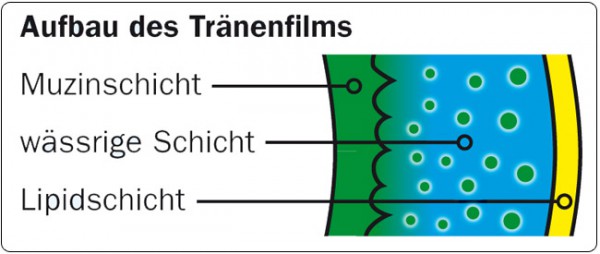Dry Eye Syndrome
Dry eye syndrome is a common condition that occurs when either the eye does not produce enough tears or when the tears evaporate too quickly (lack of fatty oils in tear film). This can result from contact lens use, meibomian gland dysfunction, allergies, pregnancy, Sjögren syndrome, vitamin A deficiency, refractive surgery (LASIK). Dry eyes feel uncomfortable. If you have dry eyes, your eyes may sting or burn. You may experience dry eyes in certain situations, such as on an airplane, in an air-conditioned room, while riding a bike or after looking at a computer screen for a few hours.
Structure of the tear film
A layer of different cells forms the conjunctiva and cornea in our eye. These main components of the anterior segment of the eye are covered by a very thin layer of liquid, the tear film. This serves as protection and nourishment for the various skins. In addition, the tear film has a cleansing effect, comparable to a windscreen wiper in a car.
Symptoms
- Burning sensation
- Itchy eyes
- Aching sensations
- Heavy eyes
- Fatigued eyes
- Sore eyes
- Dryness sensation
- Red eyes
- Photophobia
- Blurred vision (sometimes even Diplopia)
Do you have questions about this eye disease? We are happy to answer them:
Tel.: +49 30 20144610
Other symptoms
Another common symptom is something called a foreign body sensation — the feeling that grit or some other object or material is „in“ your eye. And as odd as it may sound, watery eyes also can be a symptom of dry eye syndrome. This is because dryness on the eye’s surface sometimes will over-stimulate production of the watery component of your tears as a protective mechanism. But this „reflex tearing“ does not stay on the eye long enough to correct the underlying dry eye condition. In addition to these symptoms, dry eyes can cause inflammation and (sometimes permanent) damage to the surface of the eye.
Causes of dry eye syndrome
A normal tear film consists of three important components:
- An oily (lipid) component
- A watery (aqueous) component
- A mucous-like (mucin) component
Each component of the tear film serves a critical purpose. For example, tear lipids help keep the tear film from evaporating too quickly and increase lubrication, while mucin helps anchor and spread the tears across the surface of the eye. A problem with any of these sources of tear film components can result in tear instability and dry eyes.
Factors associated with dry eye syndrome
- heavy reading or digital device (screen) use
- living/ working in dry/ windy environment
- prolonged contact lens wear
- LASIK surgery
- allergy drugs, duretics, birth control pills
- diets poor in essential fatty acids
- diabetes, lupus, Sjögren’s syndrome
- deficiency of tear producing glands
- gender: women
- aging
- frequent flying
Treatment
Thankfully, there are effective treatment options if you suffer from chronic dry eye. In some cases, routine use of artificial tears and minor behavioral modifications can significantly reduce dry eye symptoms. In other cases, you should see your eye doctor to get individually recommended eye medication.
Location Berlin
Paulig Eye & Health
Operation / Laser / Anti-Aging
Unter den Linden 16
10117 Berlin
Location Kurort Oberwiesenthal
Paulig Eye & Health
Karlsbader Straße 6
09484 Oberwiesenthal
Location Saudi Arabia
Al Faisaliah Tower
Level 18
King Fahad Highway, Olaya District | Riyadh
Kingdom of Saudi Arabia


